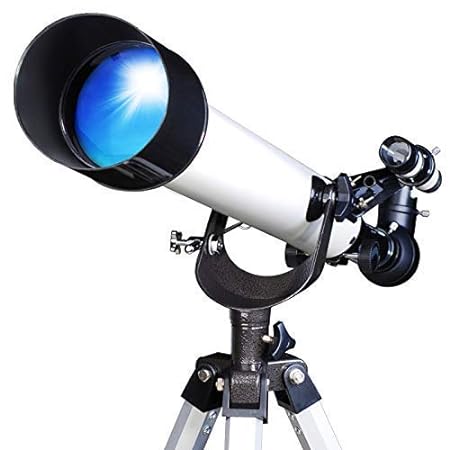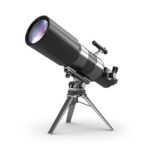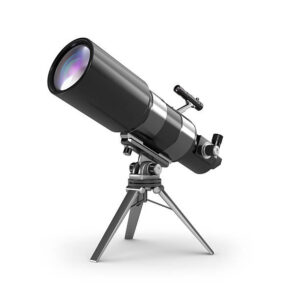Exploring the Cosmos with the 60Aaz Astronomical Telescope

The universe has always fascinated humanity with its vastness, mysteries, and beauty. To uncover these celestial secrets, astronomers have relied on various instruments over the centuries, with telescopes being one of the most important. Among these, the 60Aaz Astronomical Telescope stands out as a powerful tool for observing and understanding the cosmos. In this 2000-word article, we will delve into the history, technology, capabilities, and contributions of the 60Aaz Best Astronomical Telescope, shedding light on its vital role in expanding our knowledge of the universe.
A Brief History of Astronomical Telescopes
Before we explore the 60Aaz Astronomical Telescope, let’s take a journey back in time to understand the evolution of telescopes and their significance in the field of astronomy.
The earliest telescopes, dating back to the early 17th century, were simple optical instruments consisting of convex lenses and concave mirrors. Galileo Galilei is often credited with the invention of the first astronomical telescope, which he used to observe the Moon, Jupiter’s moons, and other celestial objects. These early telescopes, known as refractors, suffered from chromatic aberration and limited light-gathering capabilities.
In the 17th century, Isaac Newton introduced the reflecting Best Astronomical Telescope, which used mirrors instead of lenses, eliminating chromatic aberration and improving image quality. His invention laid the foundation for modern telescopic designs.
Throughout the centuries, astronomers and instrument makers continued to refine telescope technology, leading to the development of larger and more sophisticated instruments. The 60Aaz Astronomical Telescope is a notable example of such advancement.
The 60Aaz Astronomical Telescope: A Technological Marvel
The 60Aaz Best Astronomical Telescope, manufactured by a leading telescope manufacturer, is a testament to human ingenuity and technological prowess. This telescope belongs to the class of astronomical instruments known as refractors, which use lenses to gather and focus light. However, it is not just any refractor; it represents the pinnacle of optical engineering and astronomical instrumentation.
Optical Excellence
The 60Aaz Best Astronomical Telescope boasts a primary objective lens with a diameter of 60 inches (approximately 1.5 meters). This massive lens allows the telescope to gather an immense amount of light, making it an ideal instrument for observing faint and distant celestial objects. The lens is crafted with exceptional precision, minimizing optical aberrations such as chromatic and spherical aberration. This results in high-quality, sharp images that are crucial for astronomical research.
Mounting and Stability
The Best Astronomical Telescope’s mounting system plays a vital role in its performance. The 60Aaz features a robust equatorial mount that allows astronomers to track celestial objects accurately as the Earth rotates. The mount is designed to minimize vibrations and ensure stability during long observations. This stability is essential when studying distant galaxies, nebulae, and other objects that require extended exposure times to capture detailed images.
The 60Aaz Astronomical Telescope is mounted on a robust equatorial mount, ensuring precise tracking of celestial objects as the Earth rotates. Its design prioritizes stability and minimizes vibrations during extended observations, critical for capturing clear and steady images of distant phenomena. This sturdy mounting system is essential for the telescope’s effectiveness in astronomical research.
Innovative Imaging Technology
To complement its optical excellence, the 60Aaz Astronomical Telescope is equipped with cutting-edge imaging technology. The telescope includes advanced CCD (charge-coupled device) cameras and spectrographs, which enable astronomers to capture high-resolution images and spectra of celestial objects. These instruments are essential for studying the composition, temperature, and motion of astronomical phenomena.
The 60Aaz Astronomical Telescope incorporates innovative imaging technology to capture and analyze celestial phenomena. Equipped with advanced CCD cameras and spectrographs, it enables astronomers to obtain high-resolution images and spectral data of distant objects. This technology not only enhances the telescope’s observational capabilities but also facilitates in-depth research into the composition, temperature, and motion of astronomical entities.
Adaptive Optics
One of the most remarkable features of the 60Aaz Astronomical Telescope is its adaptive optics system. This technology compensates for atmospheric turbulence, which can distort the images obtained by ground-based telescopes. By using deformable mirrors and real-time feedback, adaptive optics corrects for these distortions, resulting in images that rival those from space-based observatories.
Adaptive optics is a cutting-edge technology integrated into the 60Aaz Astronomical Telescope, correcting atmospheric distortions in real-time. By using deformable mirrors and precise feedback mechanisms, adaptive optics enhances the telescope’s image quality, rivaling that of space-based observatories. This innovation significantly improves the telescope’s ability to capture sharp and clear images of celestial objects, even under turbulent atmospheric conditions.
Astronomical Discoveries Enabled by the 60Aaz Telescope
The 60Aaz Astronomical Telescope has played a pivotal role in advancing our understanding of the universe. Over the years, it has contributed to numerous groundbreaking discoveries and scientific achievements.
The 60Aaz Telescope has been pivotal in facilitating numerous astronomical discoveries. Its high-quality optics and advanced imaging technology have unveiled the intricate details of celestial objects, including stars, galaxies, nebulae, and star clusters. Additionally, its contributions to cosmology and the understanding of the universe’s expansion have been instrumental in shaping modern astrophysics.
Exploring the Solar System
The telescope has been used extensively to study our solar system. Astronomers have observed planets like Jupiter, Saturn, and Mars in unprecedented detail, capturing images of their surface features, storms, and moons. The 60Aaz Telescope has also been instrumental in tracking the movements of near-Earth objects (NEOs) such as asteroids and comets, aiding efforts to assess potential impact threats.
The 60Aaz Astronomical Telescope has played a crucial role in expanding our knowledge of the solar system, providing astronomers with detailed views of celestial bodies within it. Its precision optics have allowed scientists to study the intricate features of planets like Jupiter, Saturn, and Mars, shedding light on their atmospheres, storms, and moons. Furthermore, this telescope has contributed significantly to tracking the trajectories and behaviors of near-Earth objects (NEOs), enhancing our understanding of potential impact threats and planetary defense efforts. Its role in solar system exploration remains invaluable to astronomers and planetary scientists.

Stellar Astronomy
Studying stars has been a cornerstone of astronomical research, and the 60Aaz Telescope has made significant contributions to this field. Astronomers have used the telescope to observe distant stars, binary star systems, and variable stars. This data has led to a better understanding of stellar evolution, the birth and death of stars, and the properties of stars in various stages of their life cycles.
Stellar astronomy has greatly benefited from the 60Aaz Astronomical Telescope, which has offered unparalleled observations of distant stars, binary systems, and variable stars. Its high-resolution imaging capabilities have enabled astronomers to explore the lifecycles, behaviors, and properties of stars at various stages of their evolution. This telescope has been instrumental in unraveling the secrets of the stellar universe.
Galactic Research
The telescope’s ability to capture deep, high-resolution images has been invaluable in studying galaxies beyond our Milky Way. Astronomers have used it to examine the structure and dynamics of galaxies, including spiral galaxies, elliptical galaxies, and irregular galaxies. These observations have shed light on the formation and evolution of galaxies throughout the universe.
The 60Aaz Astronomical Telescope has played a pivotal role in advancing our knowledge of galaxies beyond our Milky Way. With its capacity for capturing deep, high-resolution images, it has provided crucial insights into the structures and dynamics of various galaxy types, including spiral, elliptical, and irregular galaxies. This research has contributed significantly to our understanding of galaxy formation and evolution.
Exploring Nebulae and Star Clusters
Nebulae, star-forming regions, and star clusters have been among the most captivating subjects for astronomers. The 60Aaz Astronomical Telescope has revealed the intricate details of these celestial objects, providing insights into the processes of star formation and the birth of new planetary systems.
The 60Aaz Astronomical Telescope has enabled astronomers to delve deep into the intricate details of nebulae and star clusters. Its high-resolution capabilities have unveiled the birthplaces of stars and the processes involved in star formation within these celestial regions. These observations have enriched our understanding of the dynamic and captivating cosmos.
Cosmological Studies
Perhaps one of the most significant contributions of the 60Aaz Telescope has been in the field of cosmology. By observing distant galaxies and measuring their redshifts, astronomers have used the telescope to gather crucial data for understanding the expansion of the universe. This data has contributed to the development of the Big Bang theory and our understanding of the age and fate of the cosmos.
Cosmological studies conducted with the 60Aaz Astronomical Telescope have been pivotal in advancing our understanding of the universe’s expansion. By observing distant galaxies and measuring their redshifts, astronomers have gathered crucial data supporting the Big Bang theory. This telescope’s contributions have provided essential insights into the age, structure, and fate of the cosmos, shaping the foundations of modern cosmology. Its role in unraveling the mysteries of the universe underscores its significance in astrophysical research.
Contributions to Space Exploration
In addition to its contributions to pure astronomy, the 60Aaz Astronomical Telescope has played a role in space exploration. It has been used to track and study spacecraft on their journeys to other planets and beyond, aiding in mission planning and data collection.
The 60Aaz Astronomical Telescope has been instrumental in tracking and studying spacecraft on their interplanetary journeys, aiding in mission planning and data collection. Its precise observations have contributed to the success of numerous space exploration missions. This telescope serves as a crucial tool in expanding our knowledge of the cosmos, supporting humanity’s endeavors to explore the far reaches of our solar system and beyond. Its role in space exploration underscores its significance in both astronomy and space science.
The Human Connection
The 60Aaz Astronomical Telescope is not just a scientific instrument; it has also captured the imagination of the public and inspired countless individuals to explore the wonders of the universe. It has been featured in educational programs, public outreach events, and documentaries, serving as a symbol of human curiosity and our desire to understand the cosmos.
Challenges and Future Prospects
While the 60Aaz Astronomical Telescope has made significant contributions to astronomy, it has also faced challenges. Maintaining such a large and complex instrument requires substantial resources and expertise. Additionally, as technology continues to advance, newer telescopes and observatories with even greater capabilities have emerged.
However, the 60Aaz Telescope remains relevant and valuable in the field of astronomy. Its historical significance, coupled with ongoing upgrades and innovations, ensures that it will continue to contribute to our understanding of the universe for years to come. Astronomers are continually pushing the limits of what this instrument can achieve, using it to tackle some of the most profound questions in astrophysics.
Conclusion
The 60Aaz Astronomical Telescope stands as a testament to human achievement and our unending quest to explore the cosmos. From its remarkable optical precision to its cutting-edge imaging technology, this telescope has played a vital role in advancing our understanding of the universe. Its contributions to solar







